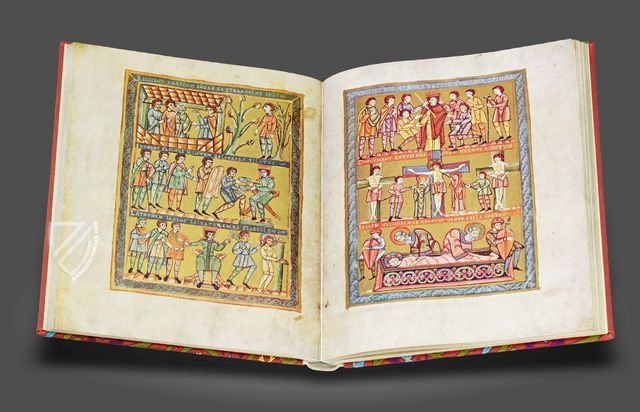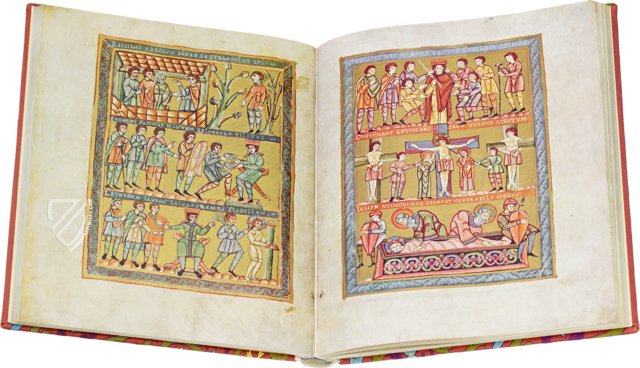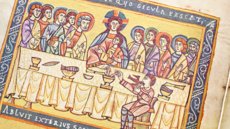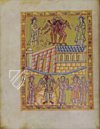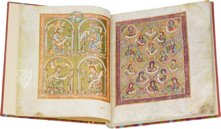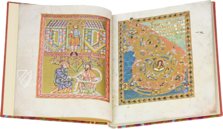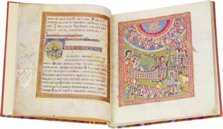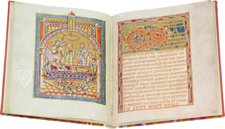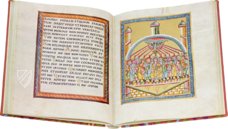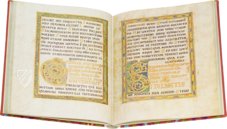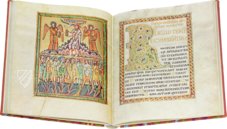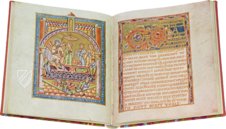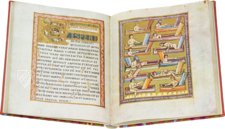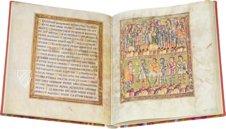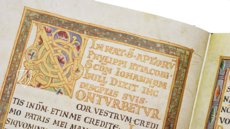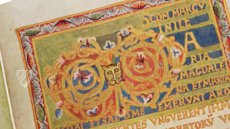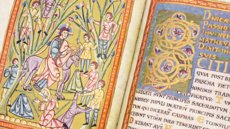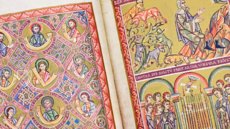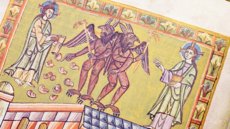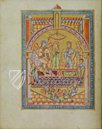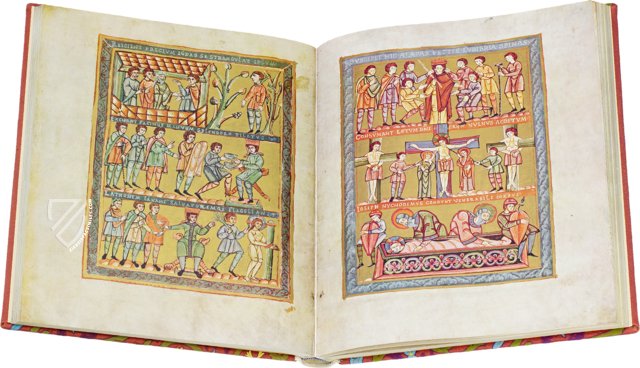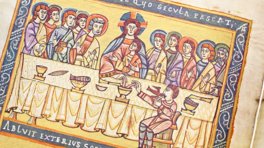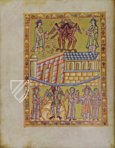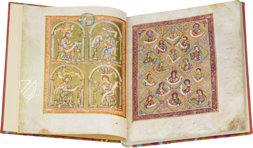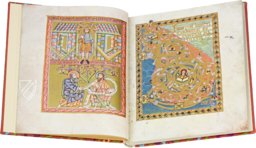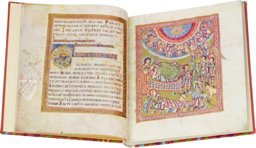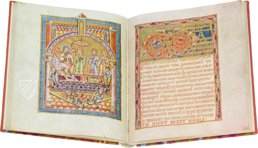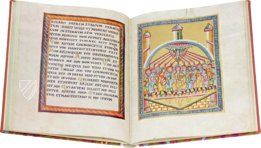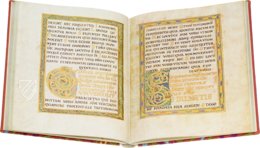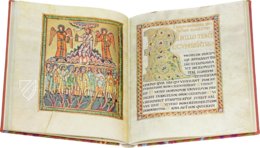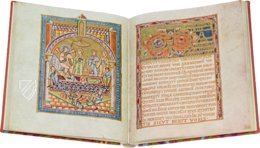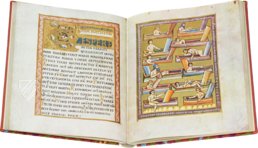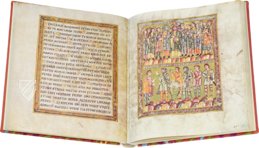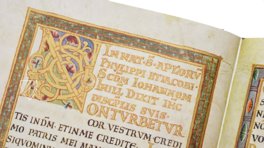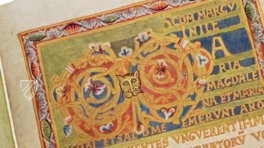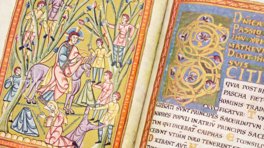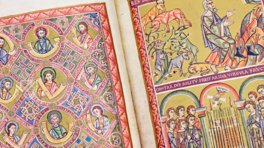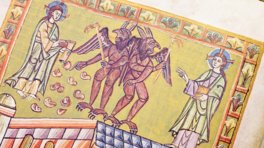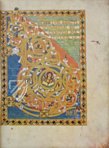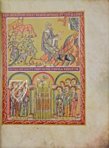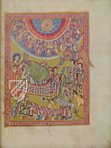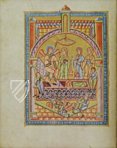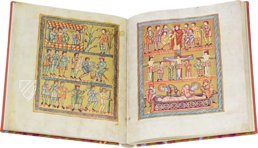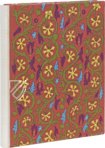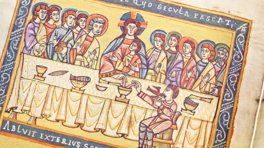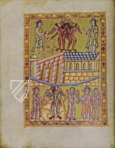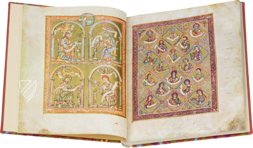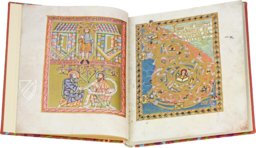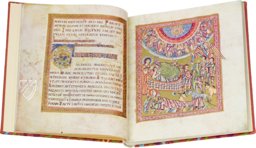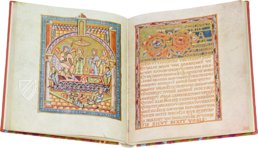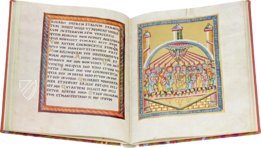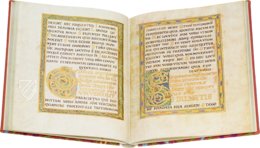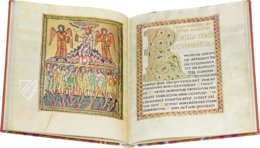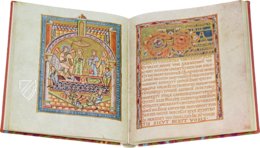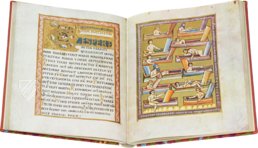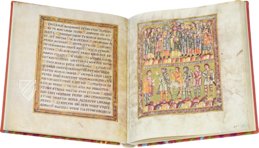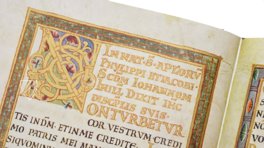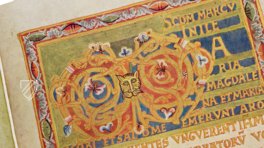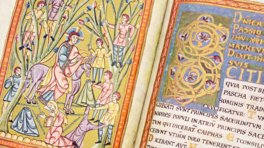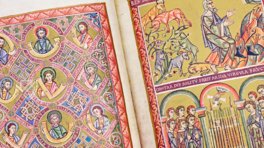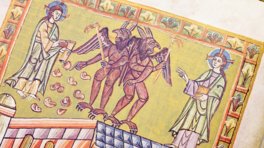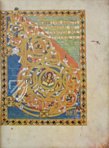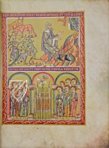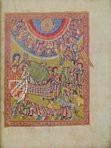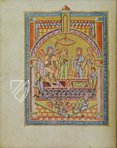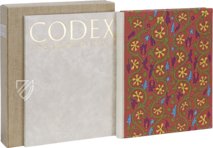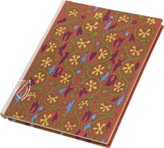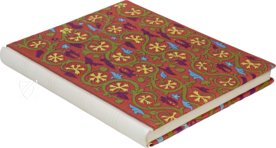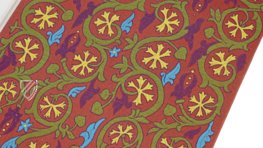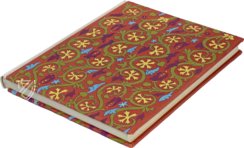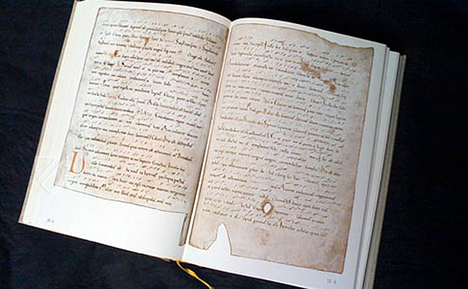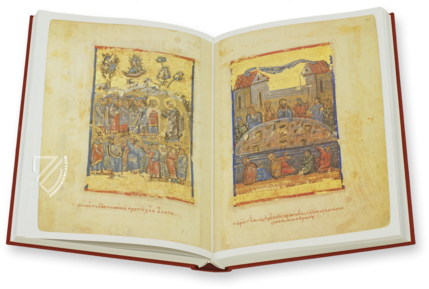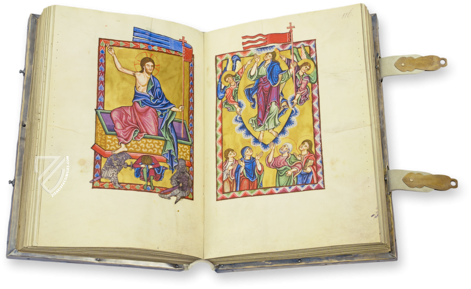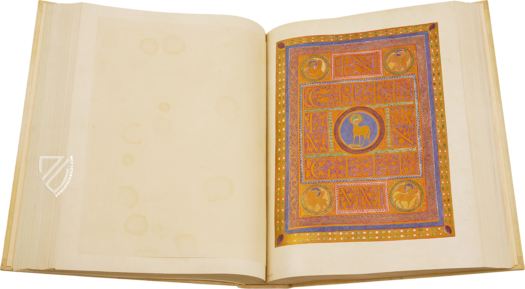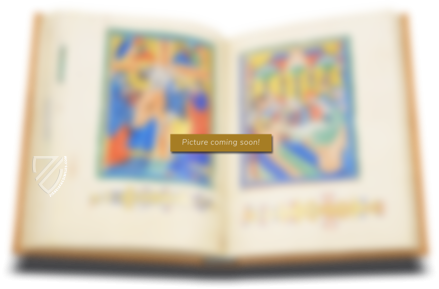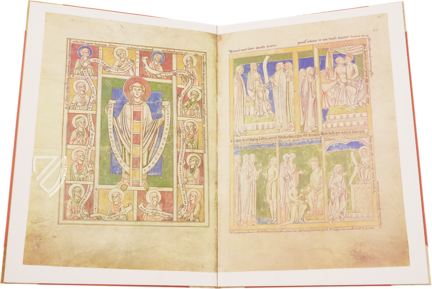Codex of Vyšehrad
(over 10,000€)
In the year 1085, Vratislaus II was crowned the first King of Bohemia, an event marked by the creation of this incredible Romanesque manuscript. The Vyšehrad Codex is the grandest of four manuscripts created by a group of artists, presumably trained in Regensburg, who were brought to Prague to commemorate the founding of a new kingdom, which was a tool of the Holy Roman Emperor Henry IV in his ongoing power struggle with the papacy. More than 60 miniatures adorn the Biblical texts in addition to elaborate initials and gorgeous frames that make this a true masterpiece of Romanesque art. The artwork is characterized by thick outlines filled in with pigments of red, pink, green, blue, purple, and brown presented before backgrounds with gold leaf. It is notable for including the earliest known representation of the Tree of Jesse, which may have been an assertion of the rightful kingship of the royal patron.
Codex of Vyšehrad
The Vyšehrad Codex, also known as the Codex Vyssegradensis in Latin, is one of the most important and most valuable manuscript kept in the modern Czech Republic. It is the Coronation Gospels of King Vratislaus, a magnificent tome made for the coronation of Vratislaus II (ca. 1032-92) as the first king of Bohemia in 1085. It is the largest and most splendidly illuminated manuscript from a group of four that was created by a team of artists in Prague between 1080 and 1085. Judging by the artistic style, this group likely originated from Regensburg and were brought to Prague for the creation of these splendid codices.
A Romanesque Masterpiece
The exceptional Romanesque illumination makes it one of the finest illuminated manuscripts from the second half of the 11th century and shows influences from Ottonian art, the Regensburg school in particular, and it is believed that the artists were foreigners who were invited to collaborate on a royal masterpiece. More than 60 miniatures adorn the Biblical texts in addition to elaborate initials and gorgeous frames. The four-page genealogy of Christ is both extremely artful and unusual in its depiction of the Tree of Jesse: instead of Christ’s ancestors, seven doves with halos perch in the branches, a motif from Byzantine art. Gold leaf has been used generously throughout the manuscript and contrasts wonderfully with the unusual, almost pastel color palette with unusual shades. Finally, the gorgeous text is written in an innovative mix of Roman capitals and uncial script.
Bavarian Illumination for a Bohemian King
The Vyšehrad Codex’s extremely rich iconography and its visual components rank it among the most precious illuminated manuscripts of the second half of the 11th century in Europe. It was probably made at the behest of Bohemian diplomats to honor an anniversary of the coronation of Duke Vratislaus II as the first King of Bohemia, which took place in 1085. The codex probably originated from the circle of the scriptorium at the Monastery of St. Emmeram in Regensburg, one of the most prolific sources for illuminated manuscripts during the period, which would have been very influential due to its proximity to Prague. Finally, it is notable for containing the earliest known representation of the Tree of Jesse, which may have been an assertion of the rightful kingship of the royal patron.
Created by an Anonymous Master
Although it is the work of several artists, the Vyšehrad Codex was a project that was apparently overseen by an artist known as the Master of the Codex Vyšehradensis. The artwork is characterized by thick outlines filled in with pigments of red, pink, green, blue, purple, and brown presented before backgrounds with gold leaf. The majuscule script is presented with spacing between words, which was unusual at the time, and the first letter of each sentence is enlarged and embellished with gold leaf and a red outline.
Part of a Political Struggle
The creation of the Kingdom of Bohemia could not have occurred without the help of Holy Roman Emperor Henry IV (1050-1106), who was engaged in a power struggle with the Papacy over the right to appoint bishops that culminated in the Investiture Crisis. As part of his campaign to limit papal power in his realms, the Emperor insisted on the retention of the Slavonic liturgy in Bohemia rather than adopting the Roman rite in order to gains the support of Vratislaus.
Codicology
- Alternative Titles
- Vyšehrad Codex
Codex Vyssegradensis
Coronation Gospels of King Vratislaus
Lectionary Ms. Codex Vyšehradensis
Coronation Codex - Size / Format
- 216 pages / 41.5 × 34.0 cm
- Origin
- Czech Republic
- Date
- 1085
- Epochs
- Style
- Genre
- Language
- Script
- Roman square capitals Roman uncial
- Illustrations
- 64 full-page miniatures of the Evangelists and the Gospels, the genealogy of Christ and with scenes from the Old Testament and the life of Christ; numerous large decorative initials of vegetative ornaments
- Content
- Lectionary, which also includes the reading for the coronation of the king
- Artist / School
- Master of the Codex Vyšehradensis (illuminator)
- Previous Owners
- Church of Vyšehrad
Library of the Prague Archbishopric Seminary
Codex of Vyšehrad
Tree of Jesse
This miniature, precisely dated to 1086, is the oldest known depiction of the Jesse Tree and is also one of the most unique iconographically. It has been argued that its purpose was to assert Vratislav II’s right to rule as the first King of Bohemia. Instead of various figures from Christ’s genealogy, as is usual, the tree supports seven doves with haloes representing the Seven Gifts of the Holy Spirit. The prophet Isiah approaches Jesse, from whose feet the tree is growing, and holds a banderole reading: "A little rod from Jesse gives rise to a splendid flower".
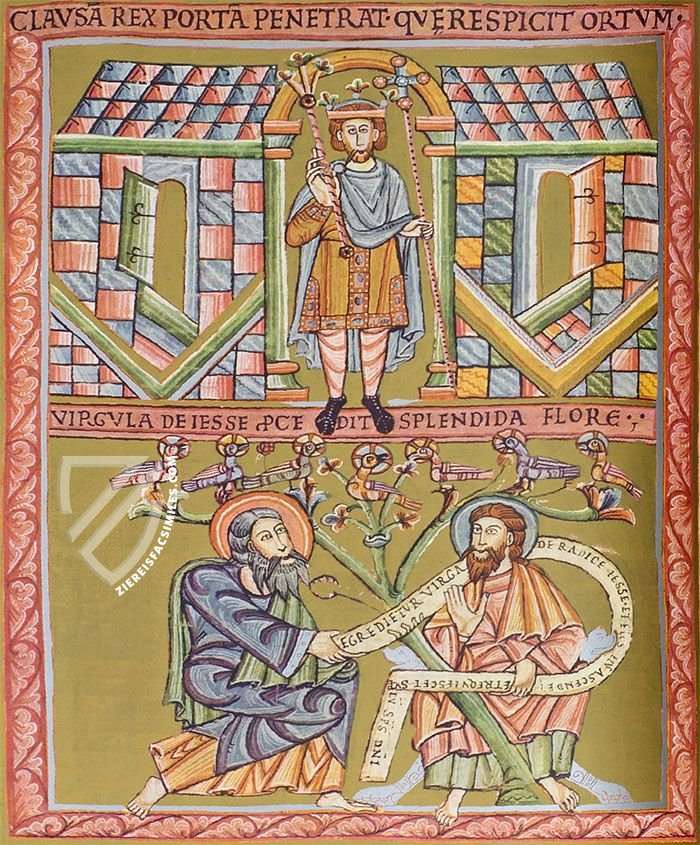
Codex of Vyšehrad
The Three Marys at the Tomb
After Jesus was laid to rest, the Three Marys returned three days later to visit the tomb, but found it is empty, the stone rolled back by an angel who sits upon it, and the soldiers guarding it are cast into a deep sleep. The angel tells them that Christ is risen and instructs them to go spread the word to his disciples and to seek him in Galilee.
The angel is depicted in a splendid robe trimmed with colorful gemstones and holding a cross-staff as he greets the Three Marys, who hold censers and jars of incense. Christ’s tomb is an elaborate sarcophagus with an intricate floral interlace pattern and is empty save for his discarded burial shroud. The soldiers guarding the tomb are small and childlike symbolizing their powerlessness in the face of an angel.
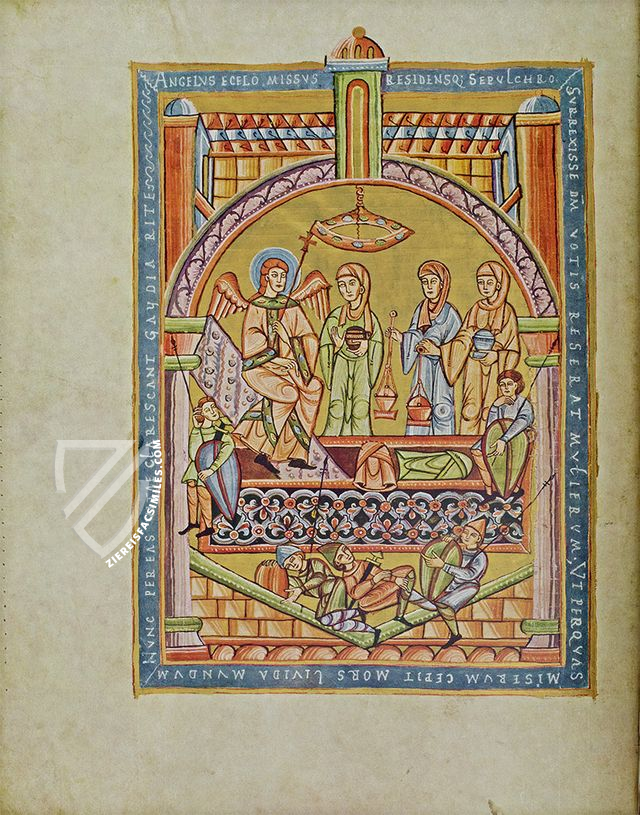
#1 Codex Vyssegradensis
Language: Czech
(over 10,000€)
#2 Codex Vysehradensis
Languages: Czech, English, French, German, Russian
(1,000€ - 3,000€)
- Treatises / Secular Books
- Apocalypses / Beatus
- Astronomy / Astrology
- Bestiaries
- Bibles / Gospels
- Chronicles / History / Law
- Geography / Maps
- Saints' Lives
- Islam / Oriental
- Judaism / Hebrew
- Single Leaf Collections
- Leonardo da Vinci
- Literature / Poetry
- Liturgical Manuscripts
- Medicine / Botany / Alchemy
- Music
- Mythology / Prophecies
- Psalters
- Other Religious Books
- Games / Hunting
- Private Devotion Books
- Other Genres
- Afghanistan
- Armenia
- Austria
- Belgium
- Belize
- Bosnia and Herzegovina
- China
- Colombia
- Costa Rica
- Croatia
- Cyprus
- Czech Republic
- Denmark
- Egypt
- El Salvador
- Ethiopia
- France
- Germany
- Greece
- Guatemala
- Honduras
- Hungary
- India
- Iran
- Iraq
- Israel
- Italy
- Japan
- Jordan
- Kazakhstan
- Kyrgyzstan
- Lebanon
- Liechtenstein
- Luxembourg
- Mexico
- Morocco
- Netherlands
- Palestine
- Panama
- Peru
- Poland
- Portugal
- Romania
- Russia
- Serbia
- Spain
- Sri Lanka
- Sweden
- Switzerland
- Syria
- Tajikistan
- Turkey
- Turkmenistan
- Ukraine
- United Kingdom
- United States
- Uzbekistan
- Vatican City
- A. Oosthoek, van Holkema & Warendorf
- Aboca Museum
- Ajuntament de Valencia
- Akademie Verlag
- Akademische Druck- u. Verlagsanstalt (ADEVA)
- Aldo Ausilio Editore - Bottega d’Erasmo
- Alecto Historical Editions
- Alkuin Verlag
- Almqvist & Wiksell
- Amilcare Pizzi
- Andreas & Andreas Verlagsbuchhandlung
- Archa 90
- Archiv Verlag
- Archivi Edizioni
- Arnold Verlag
- ARS
- Ars Magna
- ArtCodex
- AyN Ediciones
- Azimuth Editions
- Badenia Verlag
- Bärenreiter-Verlag
- Belser Verlag
- Belser Verlag / WK Wertkontor
- Benziger Verlag
- Bernardinum Wydawnictwo
- BiblioGemma
- Biblioteca Apostolica Vaticana (Vaticanstadt, Vaticanstadt)
- Bibliotheca Palatina Faksimile Verlag
- Bibliotheca Rara
- Boydell & Brewer
- Bramante Edizioni
- Bredius Genootschap
- Brepols Publishers
- British Library
- C. Weckesser
- Caixa Catalunya
- Canesi
- CAPSA, Ars Scriptoria
- Caratzas Brothers, Publishers
- Carus Verlag
- Casamassima Libri
- Centrum Cartographie Verlag GmbH
- Chavane Verlag
- Christian Brandstätter Verlag
- Circulo Cientifico
- Club Bibliófilo Versol
- Club du Livre
- CM Editores
- Collegium Graphicum
- Collezione Apocrifa Da Vinci
- Comissão Nacional para as Comemorações dos Descobrimentos Portugueses
- Coron Verlag
- Corvina
- CTHS
- D. S. Brewer
- Damon
- De Agostini/UTET
- De Nederlandsche Boekhandel
- De Schutter
- Deuschle & Stemmle
- Deutscher Verlag für Kunstwissenschaft
- DIAMM
- Droz
- E. Schreiber Graphische Kunstanstalten
- Ediciones Boreal
- Ediciones Grial
- Ediclube
- Edições Inapa
- Edilan
- Editalia
- Edition Deuschle
- Edition Georg Popp
- Edition Leipzig
- Edition Libri Illustri
- Editiones Reales Sitios S. L.
- Éditions de l'Oiseau Lyre
- Editions Medicina Rara
- Editorial Casariego
- Editorial Mintzoa
- Editrice Antenore
- Editrice Velar
- Edizioni Edison
- Egeria, S.L.
- Eikon Editores
- Electa
- Emery Walker Limited
- Enciclopèdia Catalana
- Eos-Verlag
- Ephesus Publishing
- Ernst Battenberg
- Eugrammia Press
- Extraordinary Editions
- Fackelverlag
- Facsimila Art & Edition
- Facsimile Editions Ltd.
- Facsimilia Art & Edition Ebert KG
- Faksimile Verlag
- Feuermann Verlag
- Folger Shakespeare Library
- Franco Cosimo Panini Editore
- Friedrich Wittig Verlag
- Fundación Hullera Vasco-Leonesa
- G. Braziller
- Gabriele Mazzotta Editore
- Gebr. Mann Verlag
- Gesellschaft für graphische Industrie
- Getty Research Institute
- Giovanni Domenico de Rossi
- Giunti Editore
- Graffiti
- Grafica European Center of Fine Arts
- Guido Pressler
- Guillermo Blazquez
- Gustav Kiepenheuer
- H. N. Abrams
- Harrassowitz
- Harvard University Press
- Helikon
- Hendrickson Publishers
- Henning Oppermann
- Herder Verlag
- Hes & De Graaf Publishers
- Hoepli
- Holbein-Verlag
- Houghton Library
- Hugo Schmidt Verlag
- Idion Verlag
- Il Bulino, edizioni d'arte
- ILte
- Imago
- Insel Verlag
- Insel-Verlag Anton Kippenberger
- Instituto de Estudios Altoaragoneses
- Instituto Nacional de Antropología e Historia
- Introligatornia Budnik Jerzy
- Istituto dell'Enciclopedia Italiana - Treccani
- Istituto Ellenico di Studi Bizantini e Postbizantini
- Istituto Geografico De Agostini
- Istituto Poligrafico e Zecca dello Stato
- Italarte Art Establishments
- Jan Thorbecke Verlag
- Johnson Reprint Corporation
- Josef Stocker
- Josef Stocker-Schmid
- Jugoslavija
- Karl W. Hiersemann
- Kasper Straube
- Kaydeda Ediciones
- Kindler Verlag / Coron Verlag
- Kodansha International Ltd.
- Konrad Kölbl Verlag
- Kurt Wolff Verlag
- La Liberia dello Stato
- La Linea Editrice
- La Meta Editore
- Lambert Schneider
- Landeskreditbank Baden-Württemberg
- Leo S. Olschki
- Les Incunables
- Liber Artis
- Library of Congress
- Libreria Musicale Italiana
- Lichtdruck
- Lito Immagine Editore
- Lumen Artis
- Lund Humphries
- M. Moleiro Editor
- Maison des Sciences de l'homme et de la société de Poitiers
- Manuscriptum
- Martinus Nijhoff
- Maruzen-Yushodo Co. Ltd.
- MASA
- Massada Publishers
- McGraw-Hill
- Metropolitan Museum of Art
- Militos
- Millennium Liber
- Müller & Schindler
- Nahar - Stavit
- Nahar and Steimatzky
- National Library of Wales
- Neri Pozza
- Nova Charta
- Oceanum Verlag
- Odeon
- Orbis Mediaevalis
- Orbis Pictus
- Österreichische Staatsdruckerei
- Oxford University Press
- Pageant Books
- Parzellers Buchverlag
- Patrimonio Ediciones
- Pattloch Verlag
- PIAF
- Pieper Verlag
- Plon-Nourrit et cie
- Poligrafiche Bolis
- Presses Universitaires de Strasbourg
- Prestel Verlag
- Princeton University Press
- Prisma Verlag
- Priuli & Verlucca, editori
- Pro Sport Verlag
- Propyläen Verlag
- Pytheas Books
- Quaternio Verlag Luzern
- Reales Sitios
- Recht-Verlag
- Reichert Verlag
- Reichsdruckerei
- Reprint Verlag
- Riehn & Reusch
- Roberto Vattori Editore
- Rosenkilde and Bagger
- Roxburghe Club
- Salerno Editrice
- Saltellus Press
- Sandoz
- Sarajevo Svjetlost
- Schöck ArtPrint Kft.
- Schulsinger Brothers
- Scolar Press
- Scrinium
- Scripta Maneant
- Scriptorium
- Shazar
- Siloé, arte y bibliofilia
- SISMEL - Edizioni del Galluzzo
- Sociedad Mexicana de Antropología
- Société des Bibliophiles & Iconophiles de Belgique
- Soncin Publishing
- Sorli Ediciones
- Stainer and Bell
- Studer
- Styria Verlag
- Sumptibus Pragopress
- Szegedi Tudomànyegyetem
- Taberna Libraria
- Tarshish Books
- Taschen
- Tempus Libri
- Testimonio Compañía Editorial
- Thames and Hudson
- The Clear Vue Publishing Partnership Limited
- The Facsimile Codex
- The Folio Society
- The Marquess of Normanby
- The Richard III and Yorkist History Trust
- Tip.Le.Co
- TouchArt
- TREC Publishing House
- TRI Publishing Co.
- Trident Editore
- Tuliba Collection
- Typis Regiae Officinae Polygraphicae
- Union Verlag Berlin
- Universidad de Granada
- University of California Press
- University of Chicago Press
- Urs Graf
- Vallecchi
- Van Wijnen
- VCH, Acta Humaniora
- VDI Verlag
- VEB Deutscher Verlag für Musik
- Verlag Anton Pustet / Andreas Verlag
- Verlag Bibliophile Drucke Josef Stocker
- Verlag der Münchner Drucke
- Verlag für Regionalgeschichte
- Verlag Styria
- Vicent Garcia Editores
- W. Turnowski Ltd.
- W. Turnowsky
- Waanders Printers
- Wiener Mechitharisten-Congregation (Wien, Österreich)
- Wissenschaftliche Buchgesellschaft
- Wissenschaftliche Verlagsgesellschaft
- Wydawnictwo Dolnoslaskie
- Xuntanza Editorial
- Zakład Narodowy
- Zollikofer AG

